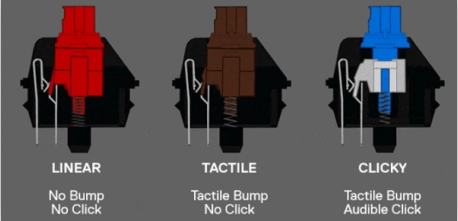We spend a lot of time talking about how we can improve the performance of our computers, but we often overlook a simple upgrade that can make our experience much better: a mechanical keyboard. Because of the coronavirus pandemic, we spend more time sitting in front of the computer. But should you opt for a mechanical keyboard? What is a mechanical switch? We're here to help.
The keyboards that we commonly see on a laptop usually come with the rubber dome design. You press all the keys, and the contact on the dome triggers the keystroke. The downside is that the rubber keyboard feels mushy and inconsistent when pressed, and you have to push all the way down to the bottom every time. They offer a little tactile feedback, a lower travel distance, and higher actuation, which can cause pain to your fingers if you type for a long period of time.
Using a mechanical keyboard makes your typing much more efficient because of its accuracy and consistency. Many switches also have high tactile feedback to help you estimate when a press will take effect, allowing you to release and proceed to the next keystroke without touching the key to the bottom. You can experience a much smoother and faster keystroke than the keys on a cheap membrane keyboard. As long as you don't have colleagues nearby to annoy, you'll find the sound of clicking the switches are quite enjoyable.
Choose the right layout
One of the most important steps in choosing a keyboard is selecting the proper layout. You can choose from a full-size board. A full-size has all the keys you need to operate your computer without worrying about any functional layers. There is also a full number pad. The main drawback to this size is that it is fairly large and inefficient. You have to move your hand quite a long way to reach everything, and the numeric keypad means your mouse will be pushed further away from your main typing area. And this is why I personally don't like full-size keyboards.
Next up is Tenkeyless (TKL), sometimes referred to as the 80% keyboard. The layout is similar to a full-size keyboard, but there is no number pad. And, of course, there's still a number row. If that sounds stressful to you, just give it some thought. How often do you really need a dedicated number pad? Unless you're doing data entry, you can do just fine without it. This layout makes the board smaller, so you can reach everything from your main typing area.
Another one is the 60% layout, which has become very popular in the last few years. A 60% layout is smaller than TKL, with alphas, a number row, and modifiers. But you won't have arrow keys, function keys, and a number pad. All of these features still exist, but they are all in the functional layer. You need to hold the Function key and press the other key. For example, the arrows are usually Fn+ WASD or Fn+ JIKL. The main advantage of the 60% layout is that it is compact and efficient. Once you get used to the functional layer, you’ll enjoy using it. But usually, I choose a TKL keyboard. It works well for daily writing. And I don’t have to remember all the combo keys.
Choosing a Switch
So, you know what size board you want, but what do you want typing to feel like? There are three basic types of switches out there. They’re linear, tactile, and clicky.
Linear switch: smooth and linear feeling from top to bottom when pressed.
Tactile switch: a bump in the middle of key travel when pressed.
Clicky switch: a bump in the middle of key travel accompanied by a "click" sound when pressed.
For those who type very fast, clicky and tactile switches can minimize typos and avoid confusion about whether you pressed the key or not. Every time you press and hit the actuation point, the sensation of the bump feeling or clicky sound gives you feedback.
On the other hand, in fast-paced gaming such as first-person shooters, linear switches are better because there are no bumps or clicks, allowing the player to double-tap the keys easily.

It is crucial to gain experience with all these three major keyboard switch types before making a decision. If you haven't used any mechanical keyboards before, you can buy a cheap switch tester that has different mechanical switches allowing you to try before buying it.
Alternatively, you might consider using a mechanical keyboard with hot-swap sockets. These types of modular sockets literally allow switches to be snapped in and pulled out without having to desolder and then resolder into contacts. Replacing a hot-swap switch is very simple and fast. Anyone can do it.